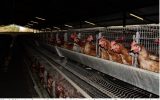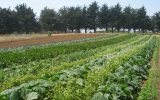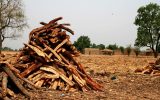Sustainable agriculture is an approach to agricultural production that stresses the improvement and preservation of the land while increasing productivity and decreasing dependency on external inputs. There are many reasons why we need to follow such an approach because it prevents deforestation, lack of groundcover, loss of broad leaf grasses for grazing,erosion,siltration of streams and lakes and other signs of environmental degradation. Dependence on artificial or inorganic fertilisers does not solve these environmental problems because it does not regenerate or improve the soil. Such dependence does not contribute to sustainable systems especially for peasant farmers working communally-owned land.
The use of inorganic chemical fertilisers highlights many of the basic objections to high-input agriculture. Although the chemicals supply food elements that plants use, the method of doing so is not the natural system. Using inorganic fertilisers can be compared to an athlete taking drugs. The drugs increase the capacity to perform and at the same time may destroy the physiology and even the structure of his body. The nutrients in artificial fertilisers are nearly all soluble- they are easily washed away. This solubility leads to an unbalanced supply of soil nutrients. In addition, soluble nitrates may reduce the numbers of beneficial soil organisms essential for stabilizing soil structure and can result in increased soil acidity and a tendency to erosion. Fertilisers do not feed the soil but merely supply a limited range of nutrients to the plant themselves.
The use of poisonous sprays to control pests, disease and weeds disrupts the natural relationships between predators and preys. When resistance to the chemical develops it increases the pest problem. Most chemical poisons affect not only the target pest, they may also destroy beneficial or non-harmful organisms. Poison sprays are particularly dangerous when used for garden produce because they create the possibility of consuming pesticide residues.
Also, experience has shown that pests develop resistance to chemical sprays. Some 450 pests have been identified as being resistant to chemicals.
This leads to the development of new, potentially-dangerous chemicals and to prohibitive costs. Chemicals may also directly injure those applying them as well as pollute the environment.
The sustainable approach to pest management recognizes not only the part the pest plays in causing crop damage but also the relationship to predators, the weather and other factors. In other words, the part played by pests in the whole system. A reasonable number of pests can be tolerated. Control methods are applied only when the population of a pest group reaches a level that threatens production. A small amount of damage should be acceptable and it may not mean a loss of profit. By relying on chemicals, farmers are losing traditional methods of pest control that are less hostile to the environment. They are also losing the skills and creativity required by traditional and natural methods. These methods are less expensive and often easily available.
The aim of sustainable agriculture is to maximize the welfare of people and the land. What is removed from the land should be returned with interest. Sustainable agriculture approaches the land and the people as an inter-connected system or ecosystem. High-input commercial farming is a business motivated by profit maximization; communal farming as it is now practiced is also an exploitative system although based on a need for food security and some cash income. The result of both is long and short-term environmental degradation. The sustainable approach requires the maintenance of a balance of fertility in the soil and biodiversity in the ecosystem as a whole. Self-reliance is a primary goal, with a lessening of dependence on outside inputs such as hybrid seeds, artificial fertilisers and pesticides. Attempts to identify or establish sustainable agricultural practices should involve farmers from the local area under consideration. Local skills can be tapped through information exchange. Questions can be answered in many cases by farmers undertaking on-farm research. Furthermore, recognition of the value of local knowledge encourages farmers to respect, protect and develop their resources. Extensionists and those who work with communal farmers need to develop facilitating and participatory skills to maximize the use of farmer-based information.
The approach of bringing the agricultural system closer to the natural systems can be assisted by planning or design. This means looking at the farm system as a micro ecosystem and recycling materials and energy among its interdependent parts. Some examples are: using chickens in movable enclosures to break up compacted soil and at the same time fertilise the ground; recycling organic waste products from the compound for compost; emphasizing crop diversity; and re-creating habitats for small insect-eating animals.
Helen L. Vukasin




















